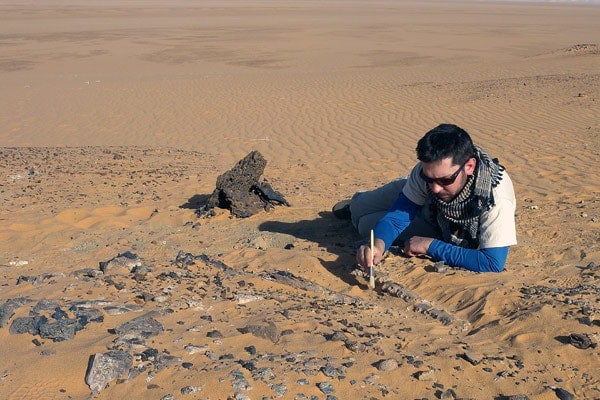
Dinosaur hunting around the world
Published: November 21, 2012
Earlier this year, Professor Ray Jayawardhana, Canada Research Chair in Observational Astrophysics, was named the University of Toronto President’s Senior Advisor on Science Engagement. Since then, Jayawardhana has been building partnerships with groups in the Greater Toronto Area aimed at promoting outreach by U of T scientists.
“I feel strongly about the value of scientists reaching out and engaging with the wider community, not only to report on our discoveries but also to share the excitement and challenges of the scientific process, to inspire kids and to encourage innovation,” Jayawardhana says.
Among the events organized so far: a series of public talks hosted by the Toronto Public Library. On Oct. 24, Associate Professor Nathan Lovejoy discussed Chasing Electric Fish in the Amazon and on Nov. 15, Assistant Professor Megan Frederickson gave a talk on killer ants in the Peruvian Amazon.
Next up is David Evans, an assistant professor of ecology and evolutionary biology at U of T and curator of vertebrate paleontology at the Royal Ontario Museum. U of T News asked Evans for a glimpse of what audiences can expect to hear about at his talks Nov 21 and Nov 26.
What drew you to this area of research?
I have always been fascinated by animals, both living and extinct, ever since I can remember. My uncle took me on trip to the Royal Ontario Museum when I was around four years old, where I saw dinosaur skeletons for the first time, and ever since then I have been hooked on dinosaurs and the history of life, and how evolution produced such amazing diversity. It has been estimated that over 99.9 percent of the species that ever existed are extinct. The fossil record documents the huge diversity of species that has existed in the past, and provides a record of how evolution happened over the last 3.5 billion years, sometimes in exquisite detail. I am particularly interested in macroevolutionary questions that cannot be addressed with living animals alone, such as the causes and consequences of mass extinction events and the relationships of biodiversity dynamics to climate change over large timescales. My main research interests focus on patterns of evolution and diversity of dinosaurs in the Late Cretaceous period, with the goal of understanding how major climate changes and sea-level shifts impacted dinosaur communities leading up to the mass extinction that marked the end of the Age of Dinosaurs.
Why are we so intrigued by dinosaurs?
I have been asked this question many times, and I find it hard to answer. The typical answer is that the size and striking anatomy of dinosaurs reminds us of fictional or mythical monsters that haunt our dreams, but unlike monsters, dinosaurs were living, breathing, evolving animals that surprisingly went extinct. But I think there is more to our collective fascination with dinosaurs than just that, because some pretty strange, and sometimes giant, mammals have evolved in the past, and we seem far less interested in them from a cultural perspective.
Can you describe a typical day in the field?
Paleontology is still in its discovery phase, and because new fossil discoveries have the potential to drastically change our perception of the history of life, I am very active in the field searching for and collecting dinosaurs and other fossils. A day in the field is similar, whether I am in the Sahara Desert, the Arctic, or Alberta. Home is a tent. Each day starts by getting up with sun, packing up your tools and lunch, and heading out to an excavation site or to a promising area with exposed rock to prospect for fossils. With the former, we sit for 8 to 10 hours a day in the hot sun and chip away at the rock encasing a skeleton or bonebed. With prospecting, we will walk the rocks for the entire day. It can be very hot, I have worked in temperatures above 50 degrees C in the Sahara. The bugs can be incessant. I have even been stalked by polar bears. Some people would find the work tedious or the conditions uncomfortable, but I find it exciting. With the next chip of rock, or after your next step, you have potential to discover something new about the history of life that no human has ever seen before. When it rains and we can’t go to our field sites, we work in camp, cataloguing or cleaning fossils.
 I do take both graduate and undergraduate students into the field with me every year. Undergrads join me as part of the Research Opportunity Program (EEB 399), and they get the full field experience in southern Alberta- still one of the best places on Earth to find dinosaurs. We have no cell phone reception, and have no Internet in camp, but it doesn’t seem anyone even realizes it. There is a constant buzz in field camp, whether it’s excavating, helping to cook meals, preparing fossils in the evenings, listening to lectures or talking science, there is always something to do – even without Internet. I certainly don’t miss the emails or phone calls, and I think the students enjoy the peace too.
I do take both graduate and undergraduate students into the field with me every year. Undergrads join me as part of the Research Opportunity Program (EEB 399), and they get the full field experience in southern Alberta- still one of the best places on Earth to find dinosaurs. We have no cell phone reception, and have no Internet in camp, but it doesn’t seem anyone even realizes it. There is a constant buzz in field camp, whether it’s excavating, helping to cook meals, preparing fossils in the evenings, listening to lectures or talking science, there is always something to do – even without Internet. I certainly don’t miss the emails or phone calls, and I think the students enjoy the peace too.
Your talk is part of a series of events designed to encourage the public to engage with science. How important is science engagement?
I believe strongly in the importance of science engagement and education. On a broad scale, having a public that understands science as a process of discovery is key to effecting positive political decisions that promote fundamental, discovery-based research and will help us adapt positively to our changing world. The science of evolutionary biology is the framework with which we understand the living natural world, and is critical to making advances in health care, food production, and biodiversity conservation, to name a just a few things relevant to most of us.
Science education and engagement is where dinosaurs play a unique role. Whatever the ultimate reason for our collective fascination with dinosaurs, it makes them an ideal vehicle for teaching evolution and the scientific method to the public, and dinosaurs are particularly important for getting kids interested in science. Although few kids get to be like me and live out their childhood dream of being a paleontologist, many of them who were inspired by dinosaurs grow up to pursue other fields in science, and make significant advances in knowledge and understanding.
Tell us a bit about Giants from Gondwana, and why you chose to focus on dinosaurs from the Southern Hemisphere?
Ultimate Dinosaurs: Giants from Gondwana is a major special exhibition on dinosaurs from the Southern Hemisphere currently on display at the Royal Ontario Museum. I conceived the exhibition as lead curator, and I worked with a large, multi-faceted ROM team to bring the exhibition to life.
In the last few decades, some of the most exciting dinosaur discoveries have been made in the Southern hemisphere- and these have revealed an amazing diversity of strange and giant dinosaurs that are very different for their northern counterparts. This exhibition brings together many of the most significant finds, and it tells the story of dinosaurs from a southern perspective. It seeks to answer the question “Why are the dinosaurs from the south so different from those in the north?”
The answer lies in the intimate relationship between the evolution of our planet and the evolution of life. In the middle of dinosaurs reign, geological forces within the Earth tore the supercontinent of Pangaea into northern and southern halves, and the dinosaurs on the newly formed southern supercontinent of Gondwana (which consisted of all of the southern continents today, plus India) went in their own unique evolutionary directions, evolving in isolation from the northern dinosaur faunas throughout most of the Cretaceous Period. During the approximately 60 million years of isolation, ecosystems diverged, and different groups of dinosaurs rose to prominence on Gondwana and Laurasia, and a huge diversity of new species evolved in each area. Some of the southern dinosaurs evolved unusual characteristics that are quite different from what we are familiar with in the northern dinosaurs, and the exhibition features some of the most bizarre-looking, and giant, dinosaurs ever to evolve. The dinosaurs are amazing, but it is really an exhibition about evolution and I hope it gets people more interested in science.



